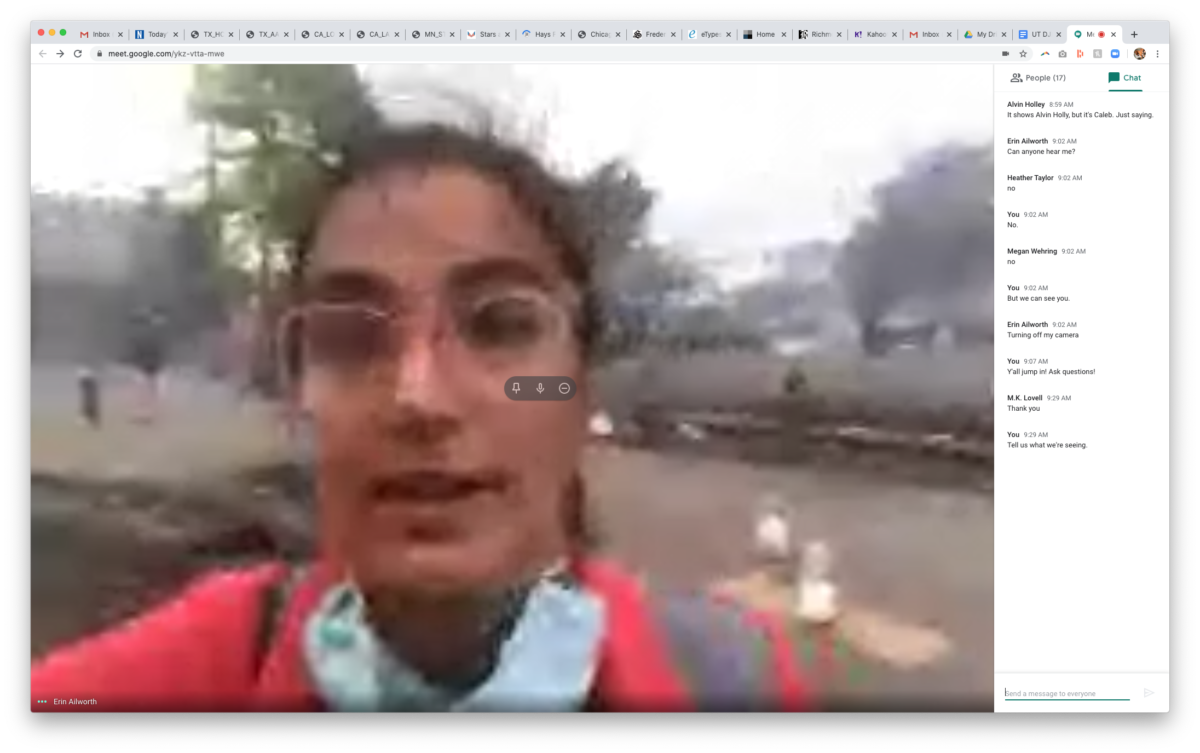‘Empathy to the forefront’
By Christine Bartruff
University of South Carolina Honors College
A chemical smell. A haze in the air. Broken windows. Abandoned jugs of milk. Through the eyes of a reporter, this was the scene in Minneapolis following protests against police brutality sparked by the killing of George Floyd.
 Erin Ailworth, Midwest correspondent for The Wall Street Journal, spoke to students via Google Hangouts while she was on the ground in Minneapolis. Ailworth is well-versed in covering heavy subject matter. She’s been The Wall Street Journal’s go-to disaster reporter since 2017, reporting on hurricanes, wildfires and, most recently, protests.
Erin Ailworth, Midwest correspondent for The Wall Street Journal, spoke to students via Google Hangouts while she was on the ground in Minneapolis. Ailworth is well-versed in covering heavy subject matter. She’s been The Wall Street Journal’s go-to disaster reporter since 2017, reporting on hurricanes, wildfires and, most recently, protests.
READ AILWORTH’S STORIES
IN THE WALL STREET JOURNAL
When interviewing people, especially those who are traumatized by the events she’s covering, Ailworth exercises empathy. Approach people gently, she said, without shoving a camera or notebook or recording device in their face. Start with introducing yourself, and then ask if they would be willing to talk with you.
The most important thing is to give the interviewee control and agency throughout the conversation because that has most likely been ripped from them, Ailworth said. She constantly checks in with the person she’s interviewing, to see if they’re OK and to remind them they can stop at any time.
“I remind them that a conversation is a two-way street. So I can ask a question. That doesn’t mean they necessarily have to answer it. Or if they think I’m not asking the right questions, they can tell me and help guide the conversation,” she said.
Ailworth said her beat can be taxing, both physically and emotionally. She stressed taking breaks and consulting a psychologist to help work through the experiences.
“Honestly, being able to tell somebody else about it helps,” she said.
Lyndsey Brennan, a 2020 Dow Jones News Fund intern and a graduate student at Kent State University, said she appreciated Ailworth’s advice on seeking help and recognizing that your reporting can affect your mental health.
Brennan said she thought about one of her own articles after Ailworth’s talk. Brennan said she had once interviewed a homeless woman for a story and couldn’t get out of bed the next day.
“I didn’t connect that the reason that I couldn’t get out of bed was because I had interviewed her,” Brennan said.
She realized her coverage was causing an internal conflict after talking with one of her professors. As Ailworth said, it can be hard to keep everything from getting to you. For her, it’s not practical to block out all emotions.
“I have to absorb some of it because I can’t otherwise put it back out there, on the page, in one of my stories,” Ailworth said.
Jordan Erb, a 2020 Dow Jones News Fund intern and a graduate student at Northeastern University, wants to be a foreign correspondent but said Ailworth inspired her to explore the disaster beat.
Erb said she liked Ailworth’s focus on empathy, adding that she will take that advice into her career, regardless of which area she ends up in. This focus includes keeping stories focused on people, people who have emotions, people who just want to be heard.
For other young journalists considering this beat, Ailworth said the most important thing is to volunteer for these kinds of stories and to talk with others who have worked in the field.
“In some ways, it’s as simplistic as saying, ‘I want to try this,’ but doing it in a smart way and where you’re going in with as much knowledge about what you might encounter as possible,” Ailworth said.
She emphasized making a safety plan with your publication’s security officer and/or editors.
But no matter what, problems can arise when doing this kind of reporting. Ailworth said a lot of the work behind the disaster beat involves troubleshooting. Things like electricity, internet access and travel into disaster areas all present their own unique problems and can make it hard to file a story.
“You kind of just deal with that stuff,” she said. “And, you know, you have to know what you can handle and what you can’t, and be really good about telling that to your editors and sometimes telling them, ‘No, that’s not going to work.’”
Through all the logistics, travel, planning and uncertainties her beat brings, Ailworth said her favorite part of the job is finding that one person who will open up and speak with her.
“The grace that is required of people to talk to you in these moments, that is always humbling,” Ailworth said.
VIEW the entire interview with Ailworth.
RESOURCES FOR JOURNALISTS:
- Dart Center for Journalism and Trauma — The Dart Center for Journalism and Trauma, a project of the Columbia University Graduate School of Journalism, is dedicated to informed, innovative and ethical news reporting on violence, conflict and tragedy. Whether the topic is street crime, family violence, natural disaster, war or human rights, effective news reporting on traumatic events demands knowledge, skill and support.
- How journalists can take care of themselves while covering trauma — Poynter article by Kari Cobham
- The Most Difficult Story: Covering Suicide on College Campuses — College Media Review article by Jena Heath and Brooke Blanton, St. Edward’s University.
- Hight reminds student journalists to take care of themselves — College Media Review article by Bradley Wilson, Midwestern State University
- Suicide Coverage a Dilemma for Media — Communication: Journalism Education Today series of articles by Bradley Wilson, editor

Christine Bartruff, a junior at the University of South Carolina Honors College, is majoring in journalism with a minor in political science. Bartruff works as the news editor for the school’s independent student newspaper, The Daily Gamecock. This summer, she is interning at the Stars and Stripes as a Dow Jones News Fund multiplatform editing intern, where she is excited to tackle the needs of a new audience.

